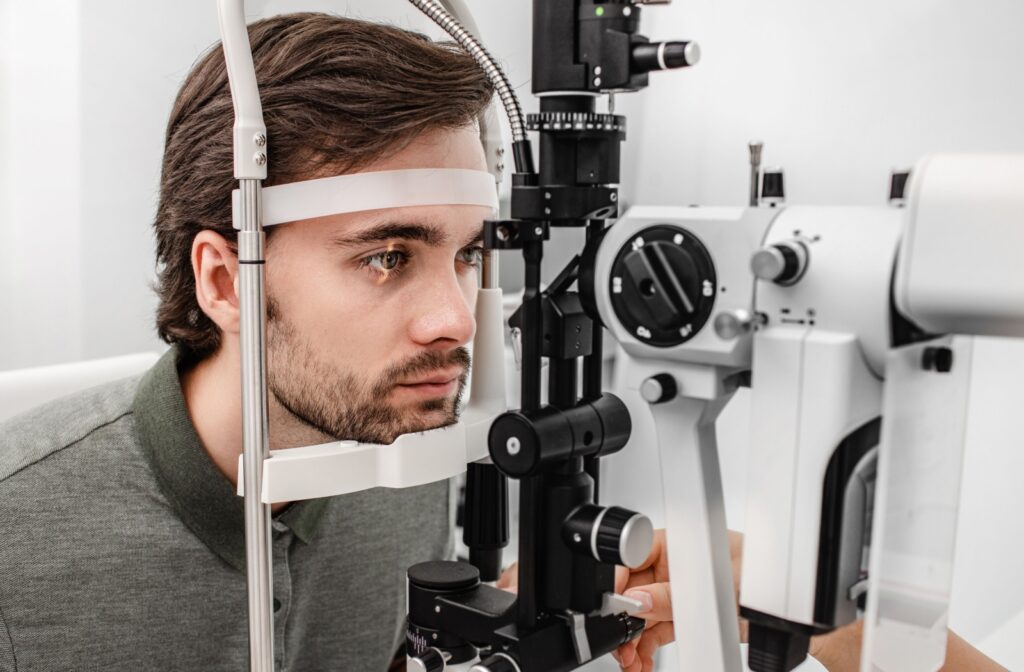We all deal with eye discomfort sometimes. It could be a minor irritation, but sometimes, it’s extremely frustrating—like the feeling of sand in your eye. That rough, gritty sensation is sometimes called foreign body sensation, and it can be very uncomfortable.
The most common cause is dry eye, an eye condition that affects your tear film. However, corneal abrasions, allergies, and inflammation can also trigger the sensation.
Don’t ignore the signs of something wrong—instead, visit your optometrist for a comprehensive eye exam so they can help you find relief.
What Is Foreign Body Sensation?
Foreign body sensation is the term used to describe the feeling that there’s something in your eye when nothing is actually there. It’s as if tiny particles are constantly hitting or scratching your eye. While it may seem just unpleasant or annoying, it isn’t always a minor problem.
Often, foreign body sensation is caused by dry eye, a condition that reduces the moisture needed to keep your eye’s surface smooth. Without proper lubrication, your eyes are overly sensitive and unprotected, leading to discomfort.
Why Does Dry Eye Inflame the Eyes?
Dry eye occurs when your eyes don’t produce enough tears or when the tears you do have evaporate too quickly. Since tears are essential for eye health, an imbalance can lead to significant discomfort.
Your tears aren’t just water. They’re made up of 3 layers:
- Watery layer, to flush away bacteria and hydrate the eye.
- Mucus layer, to keep tears fastened to the eye.
- Oily layer, to protect the tears from evaporation.
When these layers aren’t balanced properly, your eyes dry out, leading to friction when blinking. Like rubbing dry hands together, your eyes heat up and feel uncomfortable. Over time, the irritation from dryness can also inflame the surface of your eyes, worsening the sandy sensation.
Other Causes of Foreign Body Sensation
Dry eye is a leading cause of foreign body sensation but is not the only potential cause. Some conditions can even cause both dry eyes and foreign body sensation simultaneously.
This is why a professional diagnosis is so important. Your optometrist can narrow down the exact cause of your symptoms and create a custom treatment plan to help you find relief.

Corneal Injuries
Corneal abrasions can be frequent culprits. They’re often a result of accidental trauma or particles like dust getting caught under the eyelid. These scratches are often painful and can make it feel like something is stuck in your eye.
Corneal ulcers, on the other hand, are open sores on the cornea caused by severe infections, particularly in those who wear contact lenses too long or improperly.
Corneal ulcers are recognizable by:
- Redness and swelling in the eye
- Sensitivity to light
- Blurred vision or excessive tearing
Corneal injuries must be taken seriously. They can lead to long-term vision damage if left untreated.
Eyelid Inflammation (Blepharitis)
Sometimes, the sensation of sand in your eye can be traced to an issue with your eyelids rather than the eye itself. Eyelid conditions like blepharitis—a chronic condition where the edges of your eyelids become irritated and inflamed—can occur because of a buildup of bacteria, debris, or even mites along your lash line.
Blepharitis can trigger symptoms such as:
- Burning or stinging in the eyes
- Redness or swelling of the eyelids
- Crusty or flaky skin around the eyelids
- Sensitivity to light
- Watery or dry eyes
Blepharitis is also closely linked to dry eye. Keeping your eyelids clean and following proper hygiene practices can help you find relief. Your optometrist can also address blepharitis through specialized treatments that help support healthier eyes.
Conjunctivitis (Pink Eye)
Conjunctivitis—also known as pink eye—affects the thin, transparent membrane covering your eyes and inner eyelids, called the conjunctiva.
Pink eye can be complex. It can develop due to bacterial or viral infections, allergies, or environmental irritants. Alongside the telltale red or pink color of the eye, it also causes itchiness, a gritty sensation, and discharge.
Depending on whether it’s bacterial, viral, or allergy-related, treatment options for pink eye can vary. While most cases clear up on their own, your optometrist can narrow down your options.
Protect Your Comfort & Eye Health
Feeling like there’s sand in your eye may be frustrating. However, it’s a sign that your eyes need attention. Whether it’s from dryness, an undetected injury, or an irritation like blepharitis or conjunctivitis, identifying the cause is the first step toward relief.
That’s why our team at Camarillo Vision Center is ready to help. We know how uncomfortable eye conditions can be, and we’re here to help you find the relief you deserve. Book an appointment with us today, and take your first step towards clearer vision and healthier eyes.



